This was published 7 months ago
An amusing take on the perils of living in a share house - in your 30s
By Giselle Au-Nhien Nguyen, Barney Zwartz, Cameron Woodhead, Jessica Nicholas, Tony Way and Vyshnavee Wijekumar
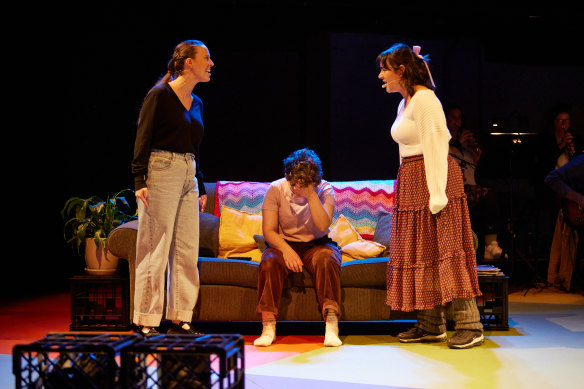
Share House: the Musical.
MUSIC/THEATRE/DANCE
Share House: The Musical
Arts Centre Melbourne, May 16-19
★★★
Share-housing in your thirties is so in right now, there’s a musical about it. Cabaret and musical comedy star Jude Perl has lived it, and if her show’s all-female household is neater and more vanilla than He Died with a Felafel in His Hand, John Birmingham’s gonzo account of Gen X share-housing, the underlying emotional conflict is the same.
Camaraderie between housemates can be genuine, but it’s never entirely unmixed by humiliation and resentment at the housing insecurity that drew you to live together in the first place. No one willingly puts up with passive-aggressive notes on the fridge, or worse, without a heavy discount on their rent.
In Share House the Musical, Lucy (Perl) lives with her childhood friend Jane (Isabelle Davis) – an inveterate cynic whose jaded worldview can be traced to betrayal and humiliation at a primary school dance concert, played out in flashbacks to younger versions of Lucy (Jasmine Turvey) and Jane (Amie Zwag).
Advertising for a new housemate, the two young women find a relentlessly upbeat dance instructor named Alice (Anita Mei La Terra). She’s the total opposite of Jane: Alice has such a pollyannaish attitude to life, she even seems to enjoy cleaning the toilet, and isn’t afraid to burst into song while doing it.
For Lucy, her housemates function rather like the angel and devil versions of cartoon characters that appear above their heads to symbolise internal conflict, and she must reconcile cynicism and optimism in her own life to get things in perspective.
Perl is one of nature’s comediennes, and the goofiness and verbal playfulness of this musical expands on the winning shtick of her cabaret.
Some of the best moments use musical theatre to explicitly satirical effect – a showstopper about Lucy’s unreachable dream of being able to afford a one-bedroom apartment leaps to mind. Vocal showdowns between housemates deftly combine music, humour, and drama, and range from soaring duets to spiky patter songs.
Yet the simplicity of the overarching narrative formula does constrain, and dilute, broader social critique, and the action feels a bit unbalanced, dramatically. Just how annoying it would be to live with full-wattage optimism all the time is sort of squashed in at the end.
Still, Share House is much funnier than the last musical I saw that tackled property ownership, Eddie Perfect’s Vivid White, and the vocal and comedic talents of the cast make for a droll evening. Anyone who’s ever lived in share-housing will laugh in recognition at the human foibles on display.
Reviewed by Cameron Woodhead
MUSIC
Macklemore ★★★★★
Rod Laver Arena, May 15
The screens start to play footage of oceans and clouds; the cymbals and trombone players commence, spurring the packed stadium to cheer with fervour. Macklemore appears under a white spotlight and launches into the opening verse of the gospel-inspired Chant, his track with Australian singer-songwriter Tones and I from his latest studio album Ben.

Macklemore at the Rod Laver Arena: maintains infectious, upbeat energy throughout his show.Credit: Richard Clifford
Following a seven-year hiatus, the Grammy award-winning 40-year-old rapper from Seattle returns to Australia and New Zealand with a sold-out tour. Due to unexpected demand, shows were added to the Sydney and Perth leg, and his Melbourne venue was upgraded from John Cain to Rod Laver Arena.
He encourages Melbourne audiences at the all-ages gig to be present by minimising phone usage, even asking seated audiences to stand to heighten their participation.
Conscious of his privilege and platform, Macklemore is unafraid to channel his music into advocacy. In 2017, he performed his single Same Love — an anthem about LGBTQIA+ rights — at the NRL grand final pre-game show during the peak of the Australian marriage equality campaign. At the concert, footage from a pride march played during this track, accompanied by rhetoric on allowing people to “love who they want to love and be who they want to be”.
More recently, the performer has been vocal on the pro-Palestine movement, releasing the single Hind’s Hall this month in support of American student protests. He even joined a campaign at the University of Sydney while touring.

Macklemore connects with the local audience.Credit: Richard Clifford
Before performing the song, he leans into didactic ideologies: “The Palestinians’ struggle has woken up my spirit in the last seven months … I stand up here today in solidarity and strength.” Lighting up the stage in green, red and white to symbolise the Palestinian flag, he concludes the song with the cry “free free Palestine”, which the crowd repeats supportively in unison.
Macklemore maintains an infectious, upbeat energy throughout his show. He skilfully jumps, bounds, claps his hands and busts a move across the stage, encouraging audiences to mimic him. The musicians and backup singers join in the fun, performing choreographed moves alongside the two onstage dancers. Sporadic pyrotechnics fire up the crowd.
After Dance Off, he gets two audience volunteers on stage to improvise a routine, applauding them for their willingness to be vulnerable. He dons a giant brown fur coat for hit Thrift Shop and even jumps on the drums during the rendition of Downtown, while he travels into the crowd for Can’t Hold Us, with the front rows holding him up so he remains visible. He slows things down for Otherside to complement its serious message on the synonymity of drug use and rap culture.
His crowd engagement demonstrates an understanding of the local audience, agreeing to do a shoey with coconut water (given his sobriety) and even wearing a Matildas jersey at one point.
Macklemore brought the club atmosphere, leaving patrons on a high by the end. He shows gratitude to fans, stating “thank you for being a part of my story”.
He states enthusiastically: “This one goes down in the history books … we did that shit!”
Reviewed by Vyshnavee Wijekumar
DANCE
Homo Pentecostus ★★
Malthouse Theatre, until May 25
The most interesting thing about choreographer Joel Bray’s rather scrappy exploration of his relationship with the charismatic religious movement known as Pentecostalism is the way it shows his earlier – and perhaps more successful – dance-theatre experiments in a new light.
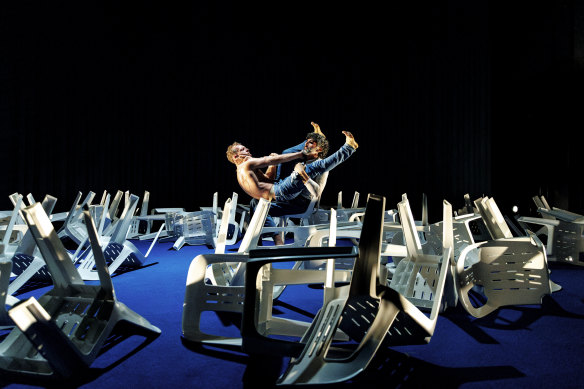
Joel Bray and Peter Paltos in Homo Pentecostus: intimate exchanges and joyful celebrations.Credit: Gianna Rizzo
Looking back, the affinities between his distinctive participatory aesthetic and the sensational appeals of modern Pentecostalism seem obvious. Intimate exchanges, joyful celebrations and a sort of touchy-feely sentimentality: this is the stuff of a Joel Bray performance.
In this show, we learn that Bray was in fact a member of a Pentecostal church but walked away when he was 18. He’s joined on stage by actor Peter Paltos, who was attracted to Pentecostalism later in life, although he too became disillusioned.
At issue is the movement’s intolerance of homosexuality and other expressions of queerness, as well as the controversial practice of deliverance, in which prayers and rituals are used to expel demons that influence behaviour.
Much of the show is a shifting bricolage of reminiscences about being young and gay and discovering what that means. There are also some thin descriptions of life in a modern Pentecostal church, combined with a discussion of how religion affects family relationships.
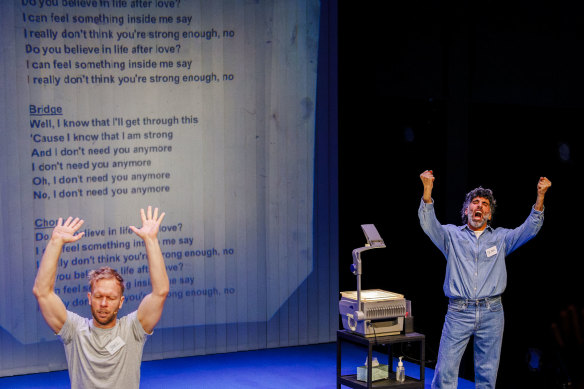
Homo Pentecostus: reminiscent of a Pentecostal service.Credit: Gianna Rizzo
The talking is juxtaposed with physical expressions of queerness and homosexual desire: poses and explicit pantomimes and extroverted dancing.
Bray strips and is naked or half-naked for much of the performance. Is this an act of affirmation? To me it felt like a substitute for genuine confession: a literal unveiling of the self in place of a genuine engagement with problems of the spirit.
At 1½ hours, the show is also much too long. The last 30 minutes is almost a complete write-off, with the two performers literally flailing about, searching for an image of closure. Pretty soon the happy-clappy vibe goes sour and it all starts to feel like hard work.
Actually, this is another way in which Joel Bray’s work is reminiscent of a Pentecostal service. It just goes on and on. It makes one yearn for the structure and concision of the Catholic Mass and its preference for symbolism over narrative. A breezy 60 minutes and you’re done.
Homo Pentecostus raises intriguing questions about the interplay of spirit and flesh. Its enigmatic, fragmentary structure is appealing, yet too much remains hidden, and what’s visible feels insubstantial. It fascinates, like a rough draft or provisional sketch, but is too limited to really enjoy.
Reviewed by Andrew Fuhrmann
MUSIC
Esme Quartet ★★★★
Musica Viva, Melbourne Recital Centre, May 14
Formed originally as a kind of Korean, classical-music girl band during student days in Cologne, the Esme Quartet is now a seriously impressive voice in the string quartet world, as this final concert in its first Musica Viva tour amply demonstrated.
With Belgian-American violist Dimitri Murrath joining violinists Wonhee Bae, Yuna Ha and cellist Yeeun Heo in April 2023, the lineup is no longer exclusively female or Korean, but the dynamism, exactitude and homogeneity of sound that propelled the group to notoriety is still very much alive and well.
Such qualities were well exploited in a rewarding program, beginning with Anton Webern’s early Langsamer Satz (Slow Movement); the quartet spinning long lines of richly inventive material that cohered into a captivating, harmonically decadent whole.
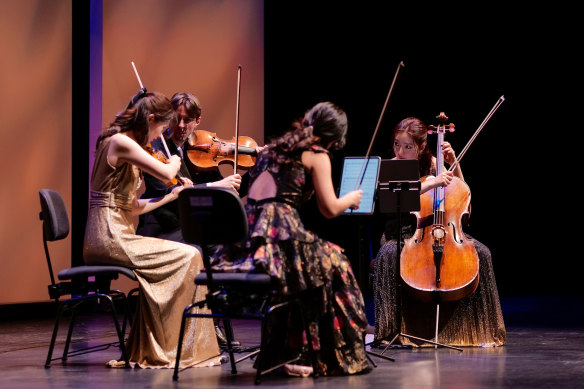
Esme Quartet: dynamism and exactitude.Credit: Tony McDonough
If Webern’s work recalled Brahms, Felix Mendelssohn’s String Quartet No. 2 in A minor, Op. 13 paid homage to Beethoven; the quartet both nimbly negotiating the work’s various textures with aplomb and delivering the celebrated Intermezzo with feeling and crystalline clarity.
Spiral Sequences by Australian-born, American-based composer Jack Frerer was a welcome discovery. Its two movements (the first quasi-minimalist, the second unwinding the tension of the first with slow-moving romantic gestures) proved an ideal vehicle for demonstrating the quartet’s stylistic versatility.
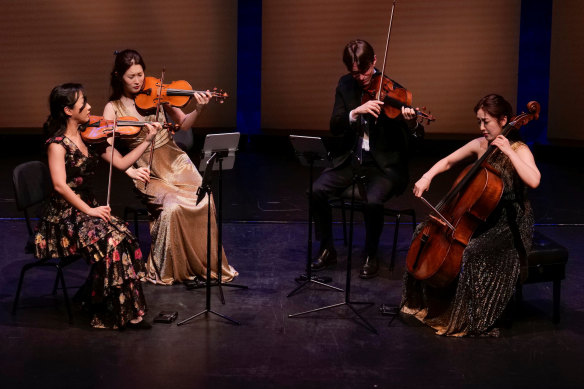
Esme Quartet displayed their stylistic versatility.Credit: Tony McDonough
A taut, vibrant account of Debussy’s String Quartet in G minor, Op. 10 crowned the program. Digging into the rhythms and textures of the first two movements, the players once again delivered carefully calibrated textures and dynamics to animate the score. During the final two movements, there were times when the listener might have hoped for a little less polish and a greater sense of abandonment to the music’s passionate outbursts.
Hopefully, such greater spontaneity will be something audiences can enjoy should we be fortunate enough to hear the Esme on a return visit.
Reviewed by Tony Way
MUSIC
Mahler’s Song Of The Earth ★★★★
Australian Chamber Orchestra, Melbourne Recital Centre, May 13
A rare chance to hear two distinguished Australian operatic voices with the Australian Chamber Orchestra in an intriguing program resulted in a packed house for the first of three Melbourne performances of Gustav Mahler’s Das Lied von der Erde (The Song of the Earth). It was ingeniously but empathetically arranged by fellow composer and admirer Arnold Schoenberg in 1920, and later completed by German composer Rainer Riehn.
Preceding this profound, exotically flavoured meditation on life, love and death came other amorous declarations. Wagner’s Siegfried Idyll, a birthday present for his wife, Cosima, was given an ardently romantic account in its original version for 13 players.
Three songs by Mahler’s wife, Alma Mahler-Werfel, revealed a gifted and evocative compositional talent. While singing with dedication and textual insight, these songs challenged mezzo-soprano Catherine Carby as they predominantly sat low in her range, where the orchestration (by British composer David Matthews) did not always aid the projection of the colour and clarity that were an attractive feature of the higher reaches of her instrument.
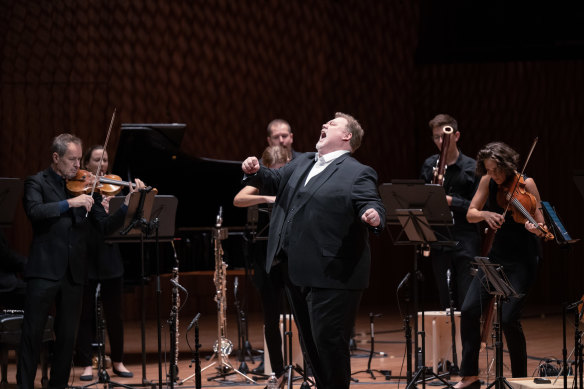
An exotically flavoured meditation on life, love and death: the Australian Chamber Orchestra with tenor Stuart Skelton.Credit: Nic Walker
Happily, the range and orchestration of the Mahler suited Carby very well indeed. This was not so true of Carby’s collaborator, tenor Stuart Skelton, who did his valiant best to cover signs of apparent vocal strain throughout his three quite demanding songs. In this, he could have been better served by ACO director Richard Tognetti, who had the ability to rein in his exuberant players, most notably in the opening song.
Carby’s contributions, however, were of stellar quality. Deeply inhabiting text and mood, especially in the long, final farewell, she radiated all the intense emotions of the human condition with disarming, heart-rending candour. Complemented by a fine ensemble that included flautist Sally Walker, pianist Stefan Cassomenos, cellist Timo-Veikko Valve and hornist Timothy Jones, this was a moving, if imperfect, night to remember.
Reviewed by Tony Way
MUSIC/THEATRE/DANCE
The Bridal Lament 哭嫁歌 ★★★★
Arts House, until May 19
In the culture of Weitou, the earliest settlers of Hong Kong from southern China, marriage was akin to a kind of spiritual death for women. As a final act of defiance before they were sent off to live with their arranged husbands, the women developed a ritual known as the bridal lament. The woman would go up to a loft for three days, and there, suspended above her world, she would sing songs to her family and friends describing what she was leaving behind.
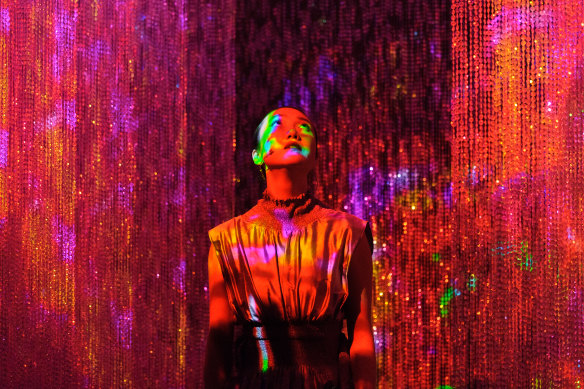
The Bridal Lament, starring Rainbow Chan, at Arts House.Credit: Sarah Walker
Multidisciplinary artist and musician Rainbow Chan, whose mother is Weitou, reimagines this world in an ambitious one-woman show, directed by Tessa Leong. After making its debut at Sydney’s Liveworks last year and heading to Adelaide’s OzAsia festival, and now playing in Melbourne, The Bridal Lament is a tender, poignant and cinematic vision of Chan’s place between cultures.
The Bridal Lament is many things at once. It has elements of music, both contemporary and ancient, as Chan’s thudding electro-pop melds with traditional Weitou laments in a song cycle form; visual art, with abstract, swirling video projections designed by Rel Pham; and spoken-word, with Chan (and her mother, Irene, via voiceover in Weitou and Cantonese) narrating the story of the rituals, and the story of their family’s migration to Australia. The backdrop is an elaborate, beaded archway, animated by dazzling colours.
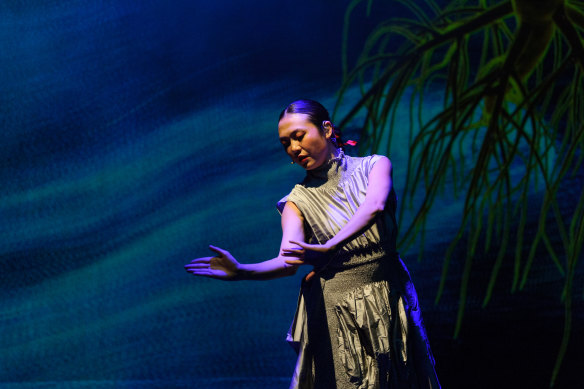
As well as her gorgeous voice, Rainbow Chan’s gliding movement is a big part of The Bridal Lament.Credit: Sarah Walker
Chan’s gorgeous voice is the backbone of the show: soft when singing the folksy laments, and furiously commanding on the more modern pop-driven music, where it is sometimes distorted with autotune. The single Seven Sisters is a particular highlight as the archway pulses with colour. Other pieces flirt with ambient styles, adding to the haunting atmosphere. Choreography also plays a part: Chan’s body contorts as she glides across the stage, or writhes on the floor. The language of the laments is translated via video, and it is stunningly poetic, with vivid imagery of fruit and animals illustrating the bride’s plight.
The meta-narration is the show’s weakest point, as Chan breaks the fourth wall to speak directly to the audience about what she experienced and learnt. While informative, it disrupts the flow of the piece, and jolts the viewer out of the liminal world of the laments.
The Bridal Lament is a rich and layered third-culture meditation on ritual, heritage and loss. When it ends, Chan is in tears. It’s a privilege to go on this emotional journey with her.
Reviewed by Giselle Au-Nhien Nguyen
MUSIC
Adrian Sherriff’s Kalachakra Ensemble ★★★★★
Mark Street Hall, May 10
Kalachakra is a Sanskrit word meaning “cycles of time” – a multidimensional concept that lies at the heart of Adrian Sherriff’s marvellous new ensemble. The group’s music is based on Carnatic (south Indian) traditions, including its complex rhythmic cycles.
And the group’s formation was inspired by a decades-long connection between two of its members – Sherriff and Sandy Evans – and the late Indian percussionist, Karaikudi R. Mani.
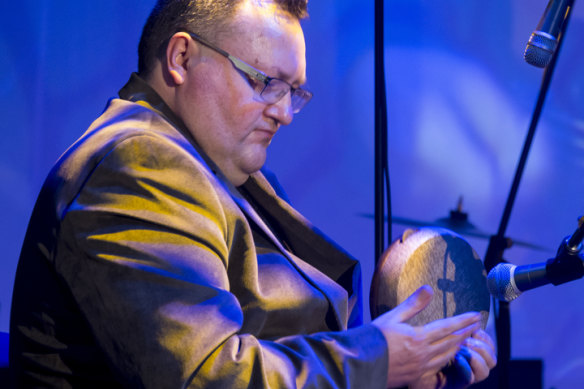
Adrian Sherriff leads the Kalachakra Ensemble.Credit: Ian Spence
The debut performance by Kalachakra on Friday night (presented by The Boite) also marked a significant anniversary: one year since Mani’s passing. Sherriff opened the concert by acknowledging Mani’s profound influence on his own musical growth, having studied and performed with the Indian master since the late 1990s.
But while Sherriff has a deep understanding of Carnatic music, he’s also a jazz artist, and this concert was an enthralling amalgam of cultures and traditions.
Sherriff, an immensely gifted multi-instrumentalist, performed on the double-headed mridangam, the instrument Mani played throughout his life. Together with the remarkable Jay Dabgar on tabla, Sherriff created elaborate rhythmic patterns that underpinned each composition.
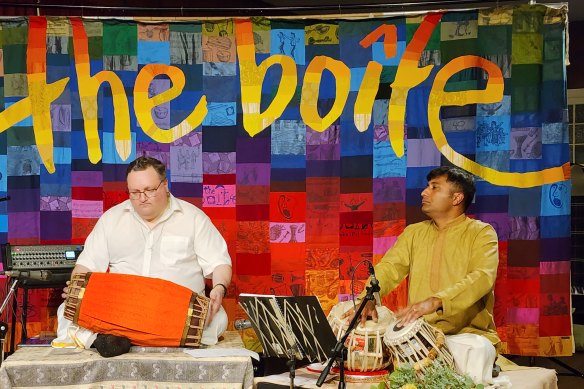
Enthralling amalgam: Adrian Sherriff was joined by the remarkable Jay Dabgar on tabla.Credit: Jessica Nicholas
Melodies based on south Indian ragas were brought to life by Evans’ saxophone, Peggy Lee’s cello and Rohan Dasika’s double bass. It was fascinating to watch these three instrumentalists articulating intricate rhythmic and melodic motifs with breathtaking unison, while also weaving in contrapuntal lines or breaking off into spirited improvisations.
Dasika and Lee switched nimbly between arco and pizzicato, adding subtle harmonics, richly resonant undertones or an undulating pulse to echo the two percussionists. Evans was frequently locked in sync with the bass and cello, but also produced some mesmerising solos, darting from note to note with astonishing agility or sinking into slow, sustained phrases with prayerful reverence.
This was a compelling tribute not just to Mani’s legacy, but to the creative processes that can carry ancient traditions into the future.
Reviewed by Jessica Nicholas
MUSIC
Jaime Conducts Debussy and Strauss ★★★★
Melbourne Symphony Orchestra, Hamer Hall, May 9
Jaime Martin and the MSO offered a night of high drama – exactly as planned – with two virtuoso works by Claude Debussy and Richard Strauss, plus a rarely played overture.
The ambitious program of Debussy’s La Mer (The Sea) and Strauss’ Ein Heldenleben (A Hero’s Life) require on the podium both a fine colourist and a master musical architect, and chief conductor Martin is both. He balanced the shape, line and proportion of each work, energetically combining both the sweep and the detail.
The MSO was augmented by one or two Australian National Academy of Music students in each section, and it must have been thrilling for them to take part in such an explosive concert before a fully appreciative audience.
First came the overture to The Wreckers, an opera about Cornish villagers who lure ships to their doom. By Dame Ethel Smyth, a suffragette whose protests meant she was jailed, it was lively and attractive.
A contemporary critic said La Mer should be titled La Mal de Mer (seasickness), while composer Erik Satie said of the movement Dawn to Noon on the Sea that he liked the bit about a quarter to 11. So did I, but I also enjoyed the rest – a subtle and characterful reading.
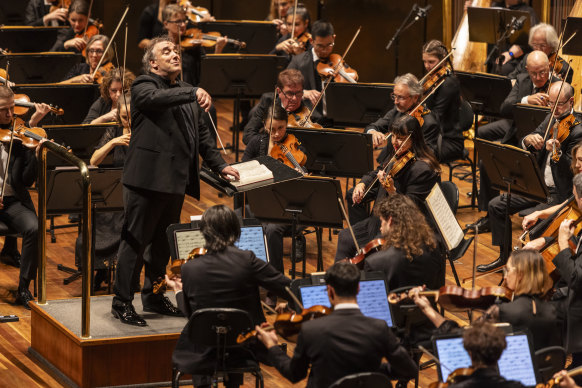
Jaime Martin and the Melbourne Symphony Orchestra provided a night of high drama.Credit: Mark Gambino
The highlight was the Strauss, rather immodestly based on the composer’s own life. “I find myself quite as interesting as Napoleon” (the original dedicatee of Beethoven’s Eroica symphony), he said.
Martin opened lickety-split, at the cost of some blurred detail, but built irresistible momentum. This tempo in the second section, “the hero’s enemies” (unsympathetic critics), with carping woodwinds and grumbling bass, made the critics all the more shrill.
Next, “the hero’s companion”, captured Strauss’ wife, Pauline, in a tender and flirtatious account distinguished by sumptuous playing by associate concertmaster Tair Khisambeev in the challenging extended solo. In summary, a formidable feat of physical fitness and concentration by all involved.
Reviewed by Barney Zwartz
THEATRE
World Problems ★★★
Emma Mary Hall, Melbourne Theatre Company, until May 22
How does knowledge of the global – including catastrophes from nuclear war to climate change – affect our experience at a personal level? How might the smallest corners of our lives be connected, through some butterfly effect, to outcomes much bigger than ourselves?
World Problems invites the audience to consider such questions, in an hour-long monologue featuring historical disasters and speculative futures, all nestled within the ephemera of childhood memory.
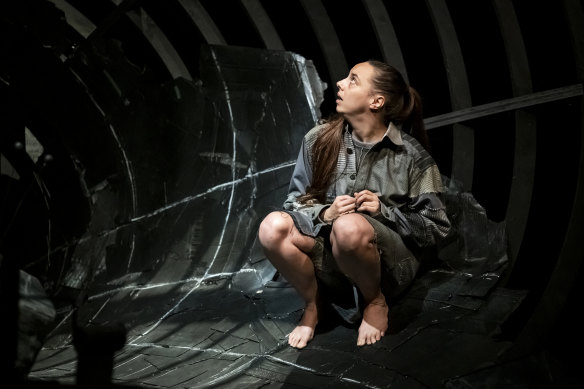
Carly Sheppard’s performance in World Problems is filled with wry wit.Credit: Tiffany Garvie
A lone woman (Carly Sheppard) scrambles through what looks like a wrecked fuselage to take the stage. Concrete fragments of recollection build a vivid, culturally precise portrait of growing up as a Gen X queer girl in the Adelaide suburbs, but the dramatic structure is quite poetic and abstract and free-associative, with a universalising impulse.
It reminded me, oddly enough, of the text in Nature Theatre of Oklahoma’s Life and Times – a masterpiece of avant-garde verbatim theatre that used recordings of a woman recalling her childhood in pedestrian detail, complete with “ums” and “ahs” – and it shares the same creative leaps, lacunae and unbidden thoughts of a person compelled to relate memories in real time.
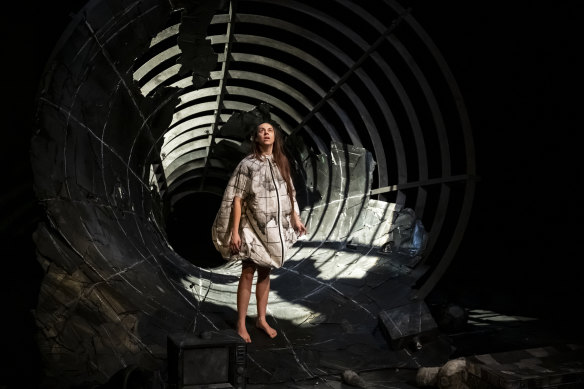
World Problems is an hour-long monologue featuring historical disasters and speculative futures.Credit: Tiffany Garvie
Sheppard wrestles the chaos of experience into narrative (or the suggestion of it) with wry wit and a coiled presence that embodies the struggle posed by self-reflection. Observations on gender and sexuality are especially sharp, but Sheppard also shows how the character’s personal and social identity are shaped by cultural trends and world events, including all the touchstones of the last generation to grow up without the internet.
As the woman remembers her young adulthood, middle age and begins to approach her present, a twist replaces memory with futuristic intimations: apocalyptic dystopias where birds fall out of the sky, or transhuman ones where technology transforms social norms, and people start marrying their own fridges or what have you.
These speculative incursions feel underdeveloped on their own terms.
They will seem more so to theatregoers who saw Sheppard’s previous one-woman show, Chase, about the last First Nations woman left alive on a ruined planet, where a similar, more elaborate dystopian technique was deployed with great success.
Still, the anticlimax doesn’t undermine the integrity of the production, nor does it overshadow the skill or charisma of the central performance, which creates an intimate interior landscape, bristling with all the questions that reflecting on your own story, and how it connects with the bigger picture, can provoke.
Reviewed by Cameron Woodhead
The Booklist is a weekly newsletter for book lovers from books editor Jason Steger. Get it every Friday.